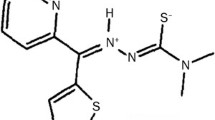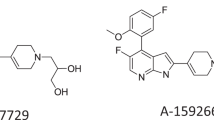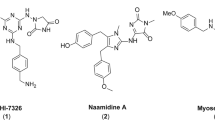Abstract
The antitumor activity of S 16020-2, a new olivacine derivative, was investigated in vivo and compared with that of Adriamycin and elliptinium acetate in a panel of murine (P388 leukemia, M5076 sarcoma, Lewis lung carcinoma, and B16 melanoma) and human (NCI-H460 non-small-cell lung and MCF7 breast carcinomas) tumor models. S 16020-2 given i.v. was active against P388 leukemia implanted i.p., s.c., or intracerebrally. The therapeutic effect of an intermittent schedule (administration on days 1, 5, 9) was superior to that of single-dose treatment, allowing the i.v. administration of high total doses of S 16020-2 and resulting in the cure of 60% of mice in the i.p. P388 model. In this model, S 16020-2 was more active than elliptinium acetate and showed a better therapeutic index than Adriamycin:≥8 versus 2. A good therapeutic effect of S 16020-2 was also observed in three P388 leukemia sublines displaying the classic multidrug-resistance phenotype, namely, P388/VCR, P388/VCR-20, and P388/MDRC.04, the latter being totally insensitive to vincristine and Adriamycin. However, S 16020-2 was not active against the P388/ADR leukemia, a model highly resistant to adriamycin in vivo. S 16020-2 was both more active than Adriamycin and curative in the M5076 sarcoma and Lewis lung carcinoma implanted s.c. In the B16 melanoma implanted i.p. or s.c., S 160202 was less active than Adriamycin. Against the NCI-H460 human tumor xenograft, S 16020-2 demonstrated activity superior to that of Adriamycin (T/C=20% versus 43% on day 21). Against the MCF7 breast cancer xenograft, S 16020-2 was active, but less so than Adriamycin (T/C=23% versus 9% on day 21), whereas elliptinium acetate was marginally active (T/C=49% on day 24). The hematological toxicity of S 16020-2 given to B6D2F1 mice at pharmacological dose appeared to be less severe than that of Adriamycin, particularly in bone-marrow stem cells. These results demonstrate that S 16020-2 is a highly active antitumor drug in various experimental tumor models and is markedly more efficient than elliptinium acetate. Because of its pharmacological profile, which is globally different from that of Adriamycin, S 16020-2 is considered an interesting candidate for clinical trials.
Similar content being viewed by others
Author information
Authors and Affiliations
Additional information
Received: 21 October 1995/Accepted: 4 March 1996
Rights and permissions
About this article
Cite this article
Guilbaud, N., Kraus-Berthier, L., Saint-Dizier, D. et al. In vivo antitumor activity of S 16020-2, a new olivacine derivative. Cancer Chemother Pharmacol 38, 513–521 (1996). https://doi.org/10.1007/s002800050520
Issue Date:
DOI: https://doi.org/10.1007/s002800050520




